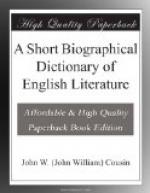LAWRENCE, GEORGE ALFRED (1827-1876).—Novelist, was a barrister. He wrote several novels, of which one—Guy Livingstone (1857)—had great popularity. On the outbreak of the American Civil War he went to America with the intention of joining the Confederate Army, but was taken prisoner and only released on promising to return to England.
LAYAMON (fl. 1200).—Metrical historian, the s. of Leovenath. All that is known of him is gathered from his own writings. He was a priest at Ernley (now Areley Regis), Worcestershire. In his day the works of Geoffrey of Monmouth and Wace, in French, were the favourite reading of the educated, and “it came to him in mind” that he would tell the story of Brut in English verse. He set out in search of books and, founding his poem on the earlier writers, he added so much from his own knowledge of Welsh and West of England tradition that while Wace’s poem consists of 15,000 lines, his extends to 32,000. Among the legends he gives are those of Locrine, Arthur, and Lear. The poem is in the old English unrhymed, alliterative verse, and “marks the revival of the English mind and spirit.”
LAYARD, SIR AUSTIN HENRY (1817-1894).—Explorer of Nineveh, b. at Paris, s. of a Ceylon civilian. After spending some years in the office of a London solicitor, he set out in search of employment in Ceylon, but passing through Western Asia, became interested in the work of excavating the remains of ancient cities. Many of his finds—human-headed bulls, etc.—were sent to the British Museum. Two books—Nineveh and its Remains (1848-49), and The Ruins of Nineveh and Babylon (1853)—brought him fame, and on his return home he received many honours, including the freedom of the City of London, the degree of D.C.L. from Oxf., and the Lord Rectorship of Aberdeen Univ. He entered Parliament, where he sat as a Liberal. He held the offices of Under-Foreign Sec. (1861-66), and Chief Commissioner of Works (1868-69), and was Ambassador to Spain 1869, and Constantinople 1877; and on his retirement in 1878 he was made G.C.B. He was a very successful excavator, and described his work brilliantly, but he was no great linguist, and most of the deciphering of the inscriptions was done by Sir H. Rawlinson. His last work was Early Adventures in Persia, etc., and he left an autobiography, pub. in 1903. He also wrote on Italian art.




